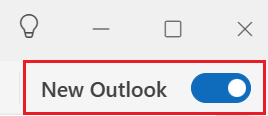Exportar o respaldar mis contactos, calendario y correo electrónico
Crea un archivo de respaldo de Outlook para guardar y exportar mensajes de correo electrónico, contactos, información de calendario y tareas. Luego importa tu respaldo a un nuevo plan de correo electrónico, servicio de correo electrónico o a una nueva versión de Outlook. La exportación no incluirá metadatos tales como propiedades de carpetas (vistas, permisos y configuración de AutoArchivar), reglas de mensajes y listas de remitentes bloqueados. Ten en cuenta que Microsoft ya no es compatible con versiones de Outlook anteriores a 2016.
Selecciona la pestaña correspondiente según la plataforma de correo electrónico que estés usando.
- Inicia sesión en Outlook en la web. Usa tu dirección de correo electrónico y contraseña de Microsoft 365 (tu nombre de usuario y contraseña de GoDaddy no funcionarán aquí).
- En la parte más a la izquierda de la página, selecciona
 Personas.
Personas. - Selecciona Administrar contactos y Exportar contactos.
- Elige si quieres exportar todos los contactos o solo los contactos de una carpeta específica, luego selecciona Exportar.
Tus contactos se guardarán en un archivo .csv, que puedes importar a otras aplicaciones de correo electrónico (como Gmail) u otras versiones de Outlook.
- Abre Outlook.
- Si estás en Outlook nuevo, regresa a Outlook clásico. En la esquina superior derecha, apaga el botón de Outlook nuevo. Es posible que debas confirmar que quieres regresar a una versión anterior.

- En la esquina superior izquierda, selecciona Archivo.
- Selecciona Abrir y exportar y luego Importar/Exportar.
- Selecciona Exportar a un archivo y Siguiente.
- Selecciona Archivo de datos de Outlook (.pst) y Siguiente.
- Para exportar el buzón completo, selecciona el nombre de la cuenta de correo electrónico y ve al paso siguiente. O, para exportar solo tus contactos, calendario o tareas, selecciona la carpeta que quieres exportar. Puedes exportar solo un tipo a la vez, por lo que tendrás que repetir estos pasos para exportar los contactos, los calendarios y las tareas de forma individual.
- Asegúrate de que esté seleccionada la casilla de verificación junto a Incluir subcarpetas y selecciona Siguiente.
- Selecciona Examinar para elegir dónde guardar el archivo de datos de Outlook (.pst). Escribe el nombre de un archivo y selecciona Aceptar.
- Si estás exportando a un archivo de datos de Outlook (.pst) existente, bajo Opciones, especifica qué hacer al exportar elementos que ya existen en el archivo.

- Selecciona Finalizar.
- La exportación comienza de inmediato, a menos que suceda una de las siguientes situaciones:
- Cuando aparece el cuadro de diálogo Crear archivo de datos de Outlook, ingresa una contraseña en Contraseña y Verificar contraseña, y selecciona Aceptar. De lo contrario, para continuar sin configurar una contraseña, deje los campos de contraseña en blanco y seleccione Aceptar.
- Si estás exportando a un archivo de datos de Outlook (.pst) existente que está protegido con contraseña, en el cuadro de diálogo Contraseña del archivo de datos de Outlook, introduce la contraseña y selecciona Aceptar.
- Abre Outlook.
- Si estás en la versión nueva de Outlook, regresa a la versión antigua. Selecciona Outlook y Outlook antiguo. Es posible que debas confirmar que quieres regresar a una versión anterior.

- Selecciona Archivo y Exportar. Se abrirá la ventana Exportar a archivo de almacenamiento (.olm).
- Si no ves Exportar, selecciona Herramientas y Exportar.
- Selecciona lo que quieras exportar. Por defecto, todos los elementos están seleccionados.
- Para exportar cualquiera de estos tipos individualmente, selecciona la casilla de verificación junto a cada elemento.

- Selecciona Continuar .
- Elige la ubicación en la que quieres guardar el archivo en tu computadora, ingresa un nombre para el archivo y selecciona Guardar. Se exportarán tus elementos.
- Selecciona Finalizar.
Paso relacionado
- Ahora que tus datos de Outlook están exportados en un archivo de respaldo, impórtalos en Outlook.
Más información
- Descubre cómo exportar un calendario a un archivo .ics de Microsoft.
- Ve más sobre exportar e importar archivos en Outlook desde Microsoft.
- Consulta este artículo en Apple para aprender a importar o exportar buzones en Apple Mail en Mac.